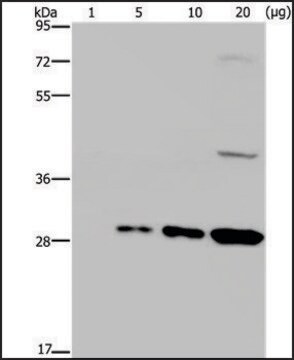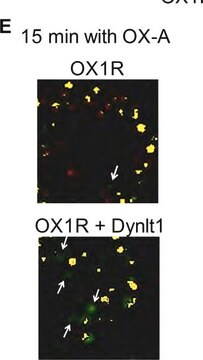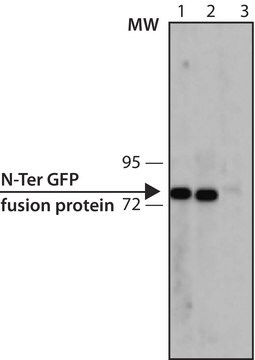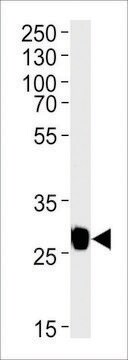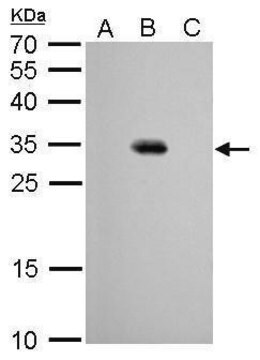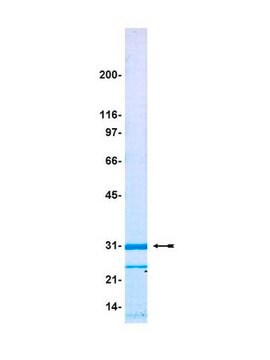おすすめの製品
由来生物
mouse
結合体
unconjugated
抗体製品の状態
purified immunoglobulin
抗体製品タイプ
primary antibodies
クローン
GSN24, monoclonal
フォーム
buffered aqueous solution
分子量
antigen 27 kDa
濃度
~2 mg/mL
テクニック
western blot: 1-2 μg/mL using GFP fusion proteins expressed in extracts of transfected cells
アイソタイプ
IgG1
輸送温度
dry ice
保管温度
−20°C
2-8°C
ターゲットの翻訳後修飾
unmodified
詳細
Anti-Green Fluorescent Protein (GFP), N-terminal antibody, Mouse monoclonal (mouse IgG1 isotype) is derived from the hybridoma GSN24 produced by the fusion of mouse myeloma cells (NS1 cells) and splenocytes from BALB/c mice.
特異性
GFP融合タンパク質と特異的に反応します。
アプリケーション
Anti-Green Fluorescent Protein (GFP), N-terminal antibody, Mouse monoclonal has been used in: western blotting, enzyme linked immunosorbent assay (ELISA), immunofluorescence labeling.
生物化学的/生理学的作用
Green Fluorescent Protein (GFP) is a unique tool in cellular and molecular biology research to monitor gene expression and protein localization in living cells. In the jellyfish, A. victoria, GFP transduces the excitation energy resulting from emission of blue light of the photoprotein aequorin and reemits it as green light.
物理的形状
0.01M PBS溶液(pH 7.4, 15mMアジ化ナトリウム含有)
保管および安定性
For continuous use, store at 2–8 °C for up to one month. For extended storage, store at –20 °C in working aliquots. Repeated freezing and thawing is not recommended. If slight turbidity occurs upon prolonged storage, clarify the solution by centrifugation before use. Solutions at working dilution should be discarded if not used within 12 hours.
免責事項
Unless otherwise stated in our catalog, our products are intended for research use only and are not to be used for any other purpose, which includes but is not limited to, unauthorized commercial uses, in vitro diagnostic uses, ex vivo or in vivo therapeutic uses or any type of consumption or application to humans or animals.
適切な製品が見つかりませんか。
製品選択ツール.をお試しください
推奨
保管分類コード
10 - Combustible liquids
WGK
WGK 3
引火点(°F)
Not applicable
引火点(℃)
Not applicable
適用法令
試験研究用途を考慮した関連法令を主に挙げております。化学物質以外については、一部の情報のみ提供しています。 製品を安全かつ合法的に使用することは、使用者の義務です。最新情報により修正される場合があります。WEBの反映には時間を要することがあるため、適宜SDSをご参照ください。
Jan Code
G6795-VAR:
G6795-200UG:
G6795-BULK:
この製品を見ている人はこちらもチェック
Marta Ukleja et al.
Nature communications, 7, 10433-10433 (2016-01-26)
CCR4-NOT is a large protein complex present both in cytoplasm and the nucleus of eukaryotic cells. Although it is involved in a variety of distinct processes related to expression of genetic information such as poly(A) tail shortening, transcription regulation, nuclear
Piet Kramer et al.
Frontiers in genetics, 7, 165-165 (2016-09-30)
The mitochondrial permeability transition pore plays a key role in programmed cell death and the induction of autophagy. Opening of the pore is regulated by the mitochondrial peptidyl prolyl-cis, trans-isomerase cyclophilin D (CYPD). Previously it was shown in the aging
Matthias Wiemer et al.
F1000Research, 3, 230-230 (2014-12-19)
The degradation of damaged proteins is an important vital function especially during aging and stress. The ubiquitin proteasome system is one of the major cellular machineries for protein degradation. Health and longevity are associated with high proteasome activity. To demonstrate
Mohammad I K Hamad et al.
Development (Cambridge, England), 141(8), 1737-1748 (2014-03-29)
The ionotropic α-amino-3-hydroxy-5-methyl-4-isoxazole propionate glutamate receptors (AMPARs) have been implicated in the establishment of dendritic architecture. The transmembrane AMPA receptor regulatory proteins (TARPs) regulate AMPAR function and trafficking into synaptic membranes. In the current study, we employ type I and
Design of inducible expression vectors for improved protein production in Ralstonia eutropha H16 derived host strains
Gruber S, et al.
Journal of Biotechnology, 235(8), 92-99 (2016)
ライフサイエンス、有機合成、材料科学、クロマトグラフィー、分析など、あらゆる分野の研究に経験のあるメンバーがおります。.
製品に関するお問い合わせはこちら(テクニカルサービス)





